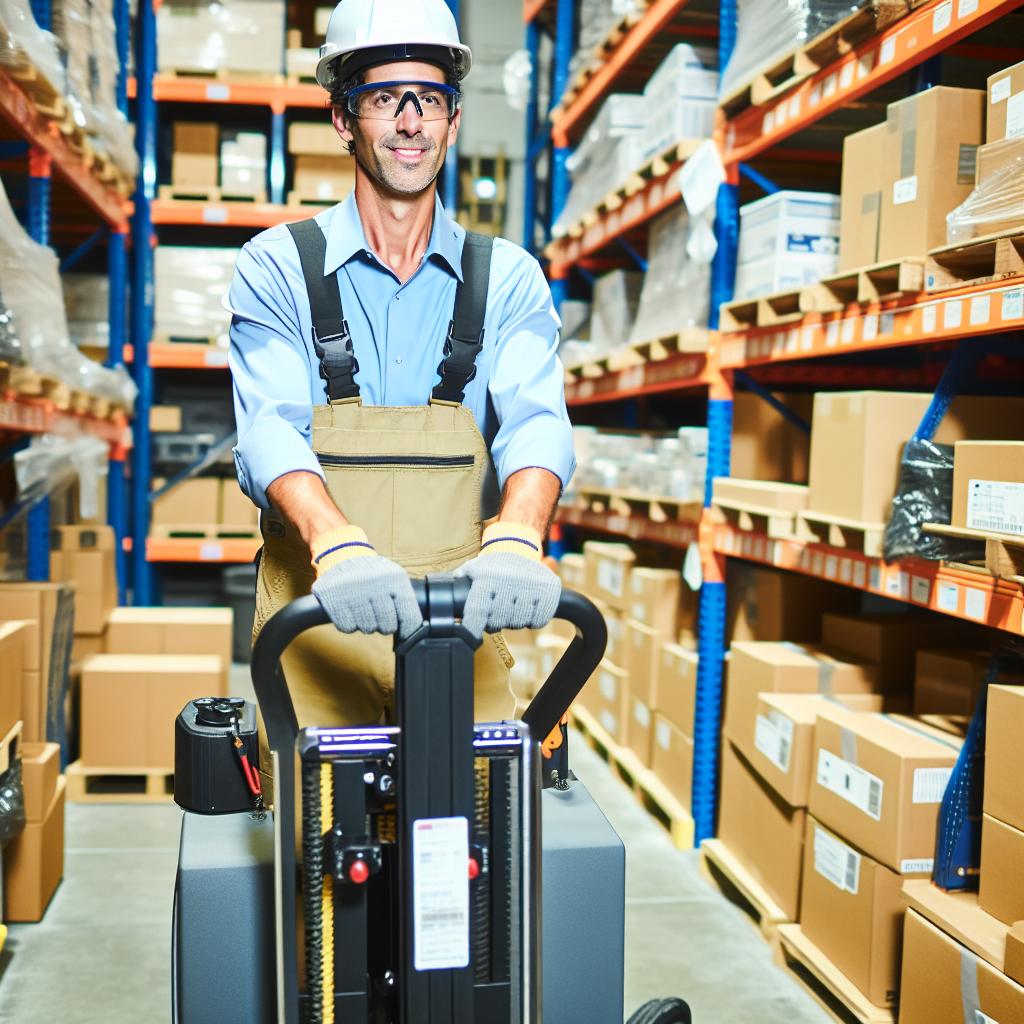Introduction:
Material handling is a critical aspect of logistics.
It involves the movement, protection, storage, and control of goods throughout the supply chain.
This process plays a vital role in ensuring efficient operations in logistics.
It facilitates the timely delivery of products to the right place at the right time.
Definition of Material Handling:
Material handling refers to the process of moving, controlling, and protecting goods within a supply chain.
It plays a crucial role in the smooth flow of materials from the point of origin to the point of consumption.
Effective material handling can significantly impact a company’s productivity and bottom line.
- Transportation: One of the key components of material handling is transportation. This involves moving goods from one location to another, whether by road, rail, air, or sea. Efficient transportation ensures that products are delivered to the right place at the right time.
- Storage: Proper storage is essential in material handling to ensure that goods are kept in a secure and organized manner. This can involve warehouses, distribution centers, or even automated systems that optimize storage space and inventory management.
- Packaging: Packaging plays a crucial role in protecting goods during transit and storage. It also includes labeling, barcoding, and other packaging techniques that help in identifying and tracking products throughout the supply chain.
Importance of Material Handling in Logistics:
Material handling plays a crucial role in optimizing operational processes within the logistics industry.
It involves the movement, protection, storage, and control of materials throughout the supply chain.
Significance of Material Handling in Logistics:
- Enhances Efficiency: Proper material handling ensures a smooth flow of goods, reducing idle time and improving overall productivity.
- Minimizes Errors: Effective handling techniques help in preventing damage to goods, reducing the risk of errors and rework.
- Optimizes Space Utilization: By organizing and stacking materials efficiently, space within warehouses and distribution centers is maximized.
- Ensures Safety: Implementing appropriate handling practices minimizes the risk of workplace accidents and promotes a safe working environment.
How Efficient Material Handling Leads to Cost Reductions:
Efficient material handling directly impacts the costs associated with logistics operations.
By streamlining processes and improving workflow, companies can achieve significant cost reductions.
- Reduces Labor Costs: Automated handling systems can perform tasks more quickly and accurately, reducing labor costs in the long run.
- Minimizes Inventory Holding Costs: Proper material handling ensures timely movement of goods, preventing excess inventory holding costs.
- Decreases Downtime: Efficient handling processes help in minimizing downtime, maximizing operational efficiency, and reducing overall costs.
- Improves Supply Chain Visibility: Effective material handling provides better visibility into the supply chain, allowing for cost-saving opportunities and improved decision-making.
Enhanced Customer Satisfaction with Efficient Material Handling:
Customer satisfaction is a key factor in the success of any logistics operation.
Efficient material handling plays a vital role in meeting customer expectations and enhancing their overall experience.
- Timely Order Fulfillment: By optimizing material flow, orders can be processed and delivered to customers in a timely manner, leading to increased satisfaction.
- Accurate Deliveries: Proper handling helps in ensuring that the right products are delivered to the right customers, minimizing errors and enhancing satisfaction levels.
- Improved Service Levels: Efficient material handling contributes to improved service levels, allowing companies to meet customer demands effectively.
- Enhanced Reputational Value: Consistently providing high-quality service through efficient handling practices enhances the reputation of the company and promotes customer loyalty.
Material handling is an essential component of logistics operations.
By focusing on efficient handling practices, companies can optimize processes, reduce costs, and improve customer satisfaction, ultimately driving business success in the competitive world of logistics.
Explore Further: Rail Yard Engineer Physical and Mental Demands
Types of Material Handling Equipment:
Material handling equipment plays a crucial role in the logistics industry.
It ensures the smooth flow of goods from one point to another.
There are several types of equipment used in material handling.
Each serves a specific purpose in the overall process.
Transform Your Career Today
Unlock a personalized career strategy that drives real results. Get tailored advice and a roadmap designed just for you.
Start NowForklifts
Forklifts are perhaps the most commonly used equipment in material handling.
They are versatile machines that can lift and move heavy loads with ease.
Forklifts come in various sizes and capacities to handle different types of materials.
These machines are essential for loading and unloading goods from trucks.
They stack and store materials in warehouses.
Forklifts transport items within a facility.
They increase efficiency and productivity by reducing manual labor.
Forklifts streamline processes effectively.
Conveyors
Conveyors are another critical piece of equipment in material handling.
They transport goods from one location to another quickly and efficiently.
Conveyors come in various forms, including belt conveyors, roller conveyors, and chain conveyors.
They are ideal for moving goods over long distances or between different levels in a facility.
Conveyors are commonly used in manufacturing plants and distribution centers.
They automate the movement of products.
Conveyors minimize the need for manual handling.
Pallet Jacks
Pallet jacks, also known as pallet trucks, are essential equipment for material handling.
They lift and move palletized goods within a warehouse or distribution center.
Pallet jacks come in manual and electric varieties.
They have different weight capacities to suit various needs.
Showcase Your Business Today
Reach thousands of readers actively exploring professional services. Publish your business profile and grow your audience now.
Publish NowThese machines are easy to operate and maneuver in tight spaces.
Pallet jacks are ideal for handling pallets of goods quickly and efficiently.
They are essential for loading and unloading trucks.
Pallet jacks transport goods to different areas of a facility.
They help organize storage spaces.
Pallet jacks save time, labor, and space effectively.
Automated Guided Vehicles (AGVs)
Automated Guided Vehicles, or AGVs, are a newer type of material handling equipment.
They are gaining popularity in logistics operations.
These self-guided vehicles are equipped with sensors and software.
AGVs navigate and transport goods autonomously.
They move materials without human intervention.
AGVs are ideal for repetitive tasks in warehouses and distribution centers.
They can transport goods along predefined routes.
AGVs pick up and drop off items at designated locations.
They optimize the flow of materials within a facility.
AGVs improve efficiency, accuracy, and safety.
Crane Systems
Crane systems are essential for lifting and moving heavy or bulky items.
They consist of various types of cranes.
This includes overhead cranes, gantry cranes, and jib cranes.
Each serves a specific purpose based on the nature of the material being handled.
Cranes are commonly used in manufacturing facilities and construction sites.
They lift and position materials with precision.
Cranes enable the efficient movement of large loads.
They reduce manual handling and minimize the risk of accidents.
Crane systems increase productivity and safety in material handling processes.
The various types of material handling equipment play a crucial role in logistics.
They streamline operations and improve efficiency.
This ensures the safe and timely movement of goods.
Each type of equipment serves a specific purpose in the material handling process.
This contributes to the overall success of logistics operations.
Explore Further: Freight Agent Impact on Supply Chain Efficiency
Benefits of Implementing Material Handling Systems:
Increased productivity is one of the key advantages of incorporating material handling systems in logistics operations.
By streamlining processes and reducing manual labor, businesses can achieve higher efficiency levels.
Safety improvements are another benefit, as material handling systems help minimize risks of accidents or injuries.
Automation plays a crucial role in enhancing material handling processes by reducing human error and increasing speed.
Technology, such as robotics and AI, can further optimize material handling operations for better results.
Real-time tracking and monitoring enable better inventory control and improved decision-making in logistics.
Cost savings are often seen when material handling systems are implemented, as they reduce waste and improve resource utilization.
Enhanced customer satisfaction is a result of faster delivery times and accurate order fulfillment enabled by efficient material handling systems.
Competitive advantage can be gained through the implementation of advanced material handling technologies, making businesses stand out in the market.
Showcase Your Business Today
Reach thousands of readers actively exploring professional services. Publish your business profile and grow your audience now.
Publish NowSustainability goals can be supported by material handling systems that promote eco-friendly practices and reduce environmental impact.
Overall, the benefits of implementing material handling systems in logistics are numerous and can lead to significant improvements in operational efficiency and effectiveness.
Find Out More: Networking Tips for Transportation Planners
Best Practices for Effective Material Handling:
When it comes to optimizing material handling operations, there are several key tips and strategies that can help improve efficiency and productivity within a logistics setting.
Proper Training for Employees:
- Ensure all employees are adequately trained in material handling procedures.
- Provide ongoing training sessions to keep skills up-to-date.
- Implement a certification program to recognize qualified handlers.
Regular Maintenance of Equipment:
- Schedule routine maintenance checks for all material handling equipment.
- Keep a detailed maintenance log to track repairs and replacements.
- Address any equipment issues promptly to prevent downtime.
Creating a Safe and Organized Workspace:
- Implement proper signage and labeling to designate material storage areas.
- Ensure aisles and walkways are clear of obstacles for safe movement.
- Incorporate ergonomic practices to reduce workplace injuries.
By following these best practices, companies can enhance their material handling operations and streamline their logistics processes for improved efficiency and overall success.
Uncover the Details: Key Skills for Rail Yard Engineers to Succeed

Common Challenges Faced in Material Handling:
When it comes to material handling, there are several challenges that companies face on a daily basis.
Addressing these challenges is crucial in ensuring the smooth operation of logistics and supply chain management.
- Inventory Management Issues:
- Workforce Productivity:
One of the most common challenges in material handling is managing inventory effectively.
Companies need to have accurate real-time data on their inventory levels to avoid stockouts or overstock situations.
Another challenge is maintaining high levels of workforce productivity.
This involves ensuring that employees are well-trained, have access to the right tools and equipment, and are able to work efficiently to meet demand.
Solutions to Overcome These Challenges:
- Implementing Warehouse Management Systems (WMS):
- Utilizing Automation and Robotics:
- Training and Development Programs:
- Implementing Lean Principles:
By investing in a WMS, companies can automate their inventory management processes, track inventory in real-time, and optimize warehouse operations for increased efficiency.
Automation technologies such as conveyor systems, automated guided vehicles (AGVs), and robotics can help improve workforce productivity.
Automation improves efficiency by streamlining material handling processes and reducing manual labor.
Providing regular training and development opportunities for employees can help improve their skills and knowledge in material handling.
This leads to increased productivity and improved operational efficiency.
Applying lean principles such as 5S, value stream mapping, and just-in-time inventory management can help companies eliminate waste.
This approach reduces lead times and improves overall material handling efficiency.
By addressing these common challenges and implementing the right solutions, companies can enhance their material handling operations.
They can optimize their supply chain management processes and ultimately improve their overall logistics performance.
Case Studies of Successful Material Handling Implementation
Company A
Company A implemented an automated material handling system to streamline their warehouse operations.
This implementation reduced order processing time by 50% and improved inventory accuracy.
As a result, Company A saw a 20% increase in order fulfillment rate and customer satisfaction.
Company B
Company B invested in a robotic picking system for their distribution center.
With this new system, they were able to handle a larger volume of orders efficiently.
This implementation led to a 30% decrease in labor costs and a 15% reduction in order fulfillment time.
Customer satisfaction levels also increased by 25% due to faster order processing.
Company C
Company C integrated a conveyor system in their manufacturing facility to streamline material flow.
The implementation of this system improved production efficiency by 40%.
As a result, Company C was able to lower their overall production costs and deliver products to customers faster.
Customer satisfaction levels increased significantly, leading to repeat business.
Company D
Company D adopted a pallet racking system in their warehouse to optimize storage space.
This implementation allowed them to store more products in a limited space.
The company saw a significant reduction in storage costs and enhanced picking efficiency.
Customers benefited from faster order processing and on-time deliveries, resulting in increased loyalty.
Company E
Company E implemented a track-and-trace system to monitor the movement of materials in real-time.
This system improved visibility across their supply chain and reduced instances of lost or damaged inventory.
The implementation led to better inventory management and accurate order fulfillment.
Customer satisfaction levels soared as they could track their orders from shipment to delivery.
Showcase Your Business Today
Reach thousands of readers actively exploring professional services. Publish your business profile and grow your audience now.
Publish NowThese case studies demonstrate the positive impact of successful material handling implementations on companies’ bottom line and customer satisfaction.
By investing in efficient material handling systems, businesses can enhance their logistics operations, reduce costs, improve productivity, and ultimately deliver superior customer service.
Importance of Material Handling in Logistics
In this blog post, we’ve discussed the crucial role of material handling in logistics.
Efficient material handling is essential to ensure smooth and streamlined supply chain operations.
By optimizing material handling practices, businesses can reduce costs, improve productivity, and enhance customer satisfaction.
Material handling is a fundamental aspect of logistics that directly impacts the overall success of a business.
It is crucial to invest in efficient material handling strategies to stay competitive in today’s fast-paced market.
By recognizing the significance of material handling in logistics, organizations can achieve operational excellence and drive business growth.
Prioritizing efficient material handling practices is key to maintaining a competitive edge and meeting the demands of modern supply chain management.
Additional Resources
Supply Chain Assessment of the Transportation Industrial Base …
Role of Logistics Equipment (Material Handling Devices) | Role of …
[E-Books for Sale]
The Big Book of 500 High-Paying Jobs in America: Unlock Your Earning Potential
$19.99 • 500 High-Paying Jobs • 330 pages
Explore 500 high-paying jobs in America and learn how to boost your career, earn more, and achieve success!
See All 500 High-Paying Jobs of this E-Book
1001 Professions Without a Degree: High-Paying American Jobs You Can Start Now
$19.99 • 1001 Professions Without a Degree • 174 pages
Discover 1001 high-paying jobs without a degree! Unlock career tips, skills, and success strategies for just $19.99!




